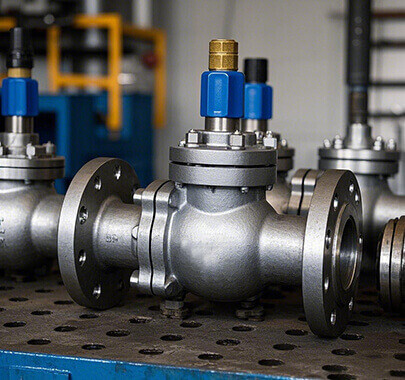

Position:
PRODUCTS
CONTACT US
Tel: +86-532-66952179/66952180
Fax: +86-532-66952181
E-mail:info@qdiflow.com
Sales office address: Unit 1517-1520, Building 4, Excellence Century Center, No. 31 Longcheng Road Qingdao, China.
Factory address: No.15, Jinshajiang Road, Tongji Street, Jimo District, Qingdao,China
What Check Valve Should I Use for My Application
2025-02-13

Check valves are crucial for preventing backflow in piping systems, which can cause damage, contamination, or system failures. Below, we'll walk through the key considerations and types of check valves available, helping you make an informed decision for your specific needs.
1. Understand Your System Requirements
- Fluid Type: Are you dealing with water, chemicals, gases, or slurries? The material compatibility of the valve with the fluid being transported is critical to prevent corrosion, erosion, or chemical reactions.
- Pressure & Temperature: What are the operating pressure and temperature ranges in your system? Different valve types handle various pressure and temperature conditions, so ensuring compatibility is vital.
- Flow Rate: What is the expected flow rate through your system? Check valves need to accommodate the flow without causing excessive pressure loss.
- Size: The valve size should match your piping system. Oversized or undersized valves can affect performance and may lead to inefficiencies.
- Application Specifics: Are you using the valve in a horizontal or vertical pipe? Will the valve be subjected to constant or intermittent flow?
2. Types of Check Valves
Swing Check Valves
- How It Works: These valves use a hinged disc to swing open with the flow and swing closed to prevent backflow.
- Best For: Low to medium-pressure systems where the flow is steady. They are commonly used in water and wastewater treatment, HVAC systems, and pumping stations.
- Pros: Simple design, reliable, and cost-effective.
- Cons: Not suitable for high-flow, high-pressure, or high-velocity applications as the swinging action may cause damage over time.
Spring-Loaded Check Valves
- How It Works: A spring forces the valve to close when the flow stops, preventing backflow. This type is often used in low-pressure systems.
- Best For: Applications where quick response is necessary, such as in pumps or systems with fluctuating pressures.
- Pros: Can handle higher velocities than swing check valves, and they close faster.
- Cons: More complex design and higher maintenance requirements due to the spring mechanism.
Ball Check Valves
- How It Works: A ball sits in a valve seat and moves with the flow. The ball is pushed away by the flow and closes against the seat to prevent reverse flow when the pressure drops.
- Best For: Simple systems with low-pressure applications and clear liquids.
- Pros: Compact and easy to install, effective for low-flow systems.
- Cons: Not ideal for high-pressure or high-temperature systems, as the ball may wear out faster.
Lift Check Valves
- How It Works: Similar to a swing check valve, but with a disc or poppet that moves vertically to open and close. It’s essentially a direct lift check valve.
- Best For: Applications where backflow needs to be prevented in high-pressure systems, typically used in vertical pipes or small to medium-sized pipelines.
- Pros: More suitable for high-pressure applications than swing check valves.
- Cons: Can cause more pressure drop compared to other types due to the valve’s design.
Tilting Disc Check Valves
- How It Works: The disc tilts away from the valve seat to allow flow and tilts back to close when reverse flow occurs. It’s more efficient in larger pipelines.
- Best For: High-flow, high-pressure applications, typically in larger systems such as large water pipelines or industrial pumping stations.
- Pros: Provides lower pressure drop and is more efficient in systems with higher velocities.
- Cons: More complex and often more expensive.
Wafer Check Valves
- How It Works: This is a compact, lightweight check valve design that fits between two flanges, with a disc that opens and closes based on the flow.
- Best For: Space-constrained applications and systems that don’t require a large flow area. Suitable for water, chemical, and food processing systems.
- Pros: Compact, cost-effective, and easy to install.
- Cons: Not suitable for high-pressure or high-flow applications.
Diaphragm Check Valves
- How It Works: These valves use a flexible diaphragm to stop the flow of fluids, providing an excellent seal. The diaphragm responds to flow and pressure, creating a leak-proof closure.
- Best For: Systems where very precise sealing is necessary, such as in pharmaceutical, medical, or food processing industries.
- Pros: High seal integrity and precise control.
- Cons: More sensitive to pressure fluctuations and may require frequent maintenance.
3. Material Considerations
- Stainless Steel: Ideal for corrosive fluids, high temperatures, and hygienic applications (food, pharmaceuticals).
- Brass or Bronze: Suitable for water, air, and low-pressure systems.
- Cast Iron: Commonly used for water and wastewater systems.
- PVC/Plastic: Best for low-pressure, non-corrosive fluids and in applications requiring lightweight materials.
4. Key Factors in Selection
- Pressure and Temperature Range: Ensure the valve can handle the maximum pressure and temperature of your system.
- Flow Velocity: Choose a valve that can handle your system’s flow velocity without causing significant resistance or turbulence.
- Maintenance: Some valves require more maintenance due to moving parts (like swing or ball check valves), while others are simpler and require less upkeep.
- Cost vs. Performance: Evaluate your budget and balance between performance and cost-effectiveness. For critical systems, investing in higher-quality valves may prevent system downtime and costly repairs.
Prev Article:Are Stainless Steel Valves Worth It